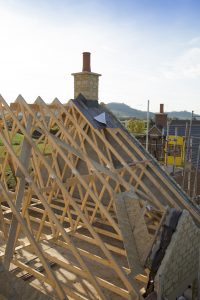
Jeremy English from Södra explains why timber offers the solution to the UK’s housing crisis, and how it can help housing providers adopt less labour-intensive, offsite building techniques to build more quickly.
Ever since Chancellor Philip Hammond‘s £15bn Autumn Budget pledge to help fix the UK‘s broken housing market, pressure on local authorities to put forward viable housebuilding plans has intensified. What’s clear is that the construction industry cannot possibly deliver these new homes using traditional building methods alone. Timber may prove to be just the answer.
Alternative housebuilding material
Strong, resilient and adaptable, timber must undoubtedly become an integral resource for the UK construction industry. It enables quicker, cheaper and less disruptive construction, with a more attractive end product than many traditional methods. Quiet to build with and naturally lightweight, it’s also ideal for brownfield site construction, urban development and building above underground structures, such as Crossrail 2.
Timber can sometimes be thought of as a weaker form of construction, but that certainly is not true — it’s remarkably strong and durable, offering assurance that regardless of speedy construction, there’s no compromise on quality. It’s also extremely versatile and offers design flexibility. A timber frame, for example, can be clad in external materials that complement specific local regulations and planning requirements.

‘Timber First’
Hackney Council’s ‘Timber First’ policy, which prioritises the use of wood as a primary construction material, is just one great case of successful, sustainable timber construction. Just 111 deliveries of materials were needed during the construction of Dalston Lane — Hackney Council’s landmark project and the largest timber housing project in the world — compared with over 700 deliveries on a typical concrete and steel project.
2,325 trees, which absorbed otherwise harmful CO², were used to build Dalston Lane. As well as reducing the carbon footprint of material production, onsite time and energy consumption were also significantly reduced.
This kind of sustainability will be crucial if the Government is to meet its ambitious target of reducing carbon emissions by 80% by 2050 — and just demonstrates the credentials timber is already bringing to the UK housing market.
Offsite Manufactured Homes (OMH)
The success of Hackney Council’s ‘Timber First’ policy coincided with the recent publication of the London Assembly’s ‘Designed, sealed, delivered’ report, which calls on the Mayor of London to utilise offsite manufactured homes to help provide more homes for Londoners.
Legal & General, for example, took over 9,000 homes from Richmond Council and committed to building thousands of timber-framed flats and houses offsite for Richmond Housing Partnership (RHP). RHP bought them for at least 15% below the standard cost for onsite construction and is set to rent them out for just £600-£700. This is a great example of timber construction being used to deliver truly affordable homes.
The case for timber outside the capital is also strong. In Tidworth, Wiltshire, 322 timber-framed homes were built for Ministry of Defence service personnel. The timber-frames were manufactured, delivered to site and erected in just 13 months — a great example of homes being built on time and in budget.
Södra Wood
We’ve established the benefits of timber-framed construction, but we also appreciate the massive pressure housebuilders are under to build quicker and more efficiently. To do this they need a reliable supply chain — Sӧdra can help.
Following our acquisition of Gloucestershire-based Crown Timber in early 2017, we’ve bolstered our distribution network and streamlined our service to the UK. With the ability to supply high-quality timber to our timber frame manufacturer customers in just 48 hours, their housebuilder clients can depend on our supply chain to get the job done in the timeframes they require.
“Just 111 deliveries of materials were needed during the construction of Dalston Lane — Hackney Council’s landmark project and the largest timber housing project in the world.”
From seed through to customer, sustainability is at the forefront of everything we do. With openness and a long-term approach, we’re developing relationships that generate added value for our customers, owners and forests.
Crucially, for every tree felled, Sӧdra plants another three and operates in line with a tree’s lifecycle. What this means is that after around 70 years, a tree stops taking in carbon dioxide — only then do we cut it down and replace it. This means the environment is receiving optimum benefit, and because we’re replacing three-fold, we’re creating a long-term, sustainable supply. Sӧdra is all about planting and growing for future generations and doing it in an ethical way.
We also have strategic sustainable objectives in place for how our business operates. For instance, we’re committed to totally fossil-free production by 2020; by 2030, so will transportation; and by 2050 the annual rate of forest growth on estates owned by Sӧdra’s members will be 20% higher than 2015. These commitments make us one of the most sustainable organisations in the industry.
Increasing global popularity
Timber frame construction currently accounts for around a quarter of housebuilding in England and Wales, but we expect to see this increase in 2018 as the UK looks to examples like Hackney Council’s ‘Timber First’ policy — and the growing success of timber-framed homes across the world.
The construction industry needs to diversify if it’s to meet government housebuilding targets. Timber offers an alternative solution and I truly believe in its ability to solve the UK’s housing crisis.
Sӧdra can help to lead the way. We know the market — our team has worked with our customers to supply the UK housing industry for many years, so we know what housing developers need. We’re also a truly integrated company. We don’t just provide timber — we also grow it. We’re a part of the process, from planting and harvesting, to delivering the final components to the timber frame manufacturer.








